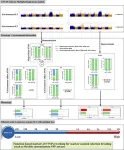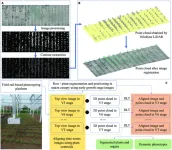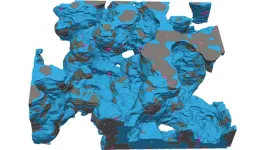(Press-News.org) Brain tumors located in regions that control speech, vision and motor function present additional challenges to neurosurgeons, as damaging the surrounding tissue can cause severe loss of those abilities.. Because of this, these regions are known as “eloquent brain areas” and require special attention and approaches to limit damage and deficits.
The University of Cincinnati’s Paolo Palmisciano, MD, was part of a research team that examined how well a minimally invasive approach worked to limit vision and hearing loss in patients following brain tumor surgery.
The research was published in the journal Brain Sciences, and the research team will receive the Mizuho Minimally Invasive Brain Tumor Surgery Award at the American Association of Neurological Surgeons (AANS) annual scientific meeting April 21-24 in Los Angeles.
Technology advances aid surgeons
Palmisciano, a postdoctoral fellow working in the Goodyear Microsurgery Lab in UC’s Department of Neurosurgery in the College of Medicine, contributed to the research prior to his current role at UC. Regardless of the approach a neurosurgeon takes, he explained, advanced technology helps them more specifically navigate directly to the tumor.
These technologies include neuronavigation, which functionally acts as a GPS to guide the surgeon exactly to the tumor. The patient’s MRI is connected with the navigation system, and surgeons can use a pen-like device to register the brain to match the MRI.
“So basically when you do the surgery, you use the pen and you touch the head of the patient and you see on the screen where you are going,” Palmisciano said. “It’s important because otherwise, you can see where the tumor is in the image but you don’t know exactly where in relation to the patient’s anatomy.”
Another technique, called cortical mapping, uses a small amount of electricity to stimulate the brain during the surgery to see if specific regions light up. This helps identify exactly where the regions that control things like speech, motor function and vision are located so that surgeons can avoid these important areas.
“Neurosurgeons know the detailed brain anatomy, but sometimes the tracts are not in the place you think they are because they are displaced by the tumor,” he said. “So you want to do cortical mapping during the surgery to see how far you are from the eloquent area.”
The third technology, tractography, specifically maps the location and direction of white matter within the brain using advanced imaging software. Palmisciano said all three techniques are used together to help surgeons remove as much of the tumor as possible while causing the least amount of damage to the surrounding tissue.
Tubular approach
Even using these new technologies, traditional methods of neurosurgery involve removing large portions of the skull, then pulling back large sections of the brain using retractors to get access to the tumor.
"When the neurosurgeon retracts the brain, the brain is mushy and very soft,” Palmisciano said. “If too much traction is used, the surgeon can cause damage to the neurons and also cause tissue death.”
The researchers studied the effectiveness of a different, minimally invasive approach using a small tube. This method involves removing a much smaller portion of the skull, and there is no need to retract the brain.
Since the imaging technology pinpoints where the tumor is located, where to avoid important brain tissue and where the shortest distance to the tumor will be, the tube can be inserted directly into the exact spot of the brain where the tumor is located, then the tumor can be removed through the tube.
“The average length of the tube is 7 centimeters, but you can also use smaller tubes,” Palmisciano said. “The neurosurgeon checks with the neuronavigation that all the tracts are not touched by the tube, puts the tube in and then puts the instrument inside the hole in the tube and to remove the tumor.”
Study results
The research team analyzed the results of 72 patients who had surgery to remove brain tumors in eloquent areas using the tubular approach from 2018-2021 at the Hospital Infantil Universitario de San Jose in Bogota, Colombia. Because brain tumors in eloquent areas are relatively rare, the prospective observational study was not limited to a specific brain tumor type or region.
“The goal was to see if we can have a lower incidence of complications in this and also to discuss the technique,” said Palmisciano, who contributed to the multicenter analysis of the data.
The research team found that almost 95% of patients in the study had their entire tumors removed using the tubular approach.
“As you can imagine, that’s a huge achievement,” Palmisciano said. “Instead of doing a big opening, we’re just using this small tube.”
Following surgery, 9% of patients had new or worse speech or motor function deficits, which is within the expected complication rate for surgery to remove tumors in these areas of the brain. Palmisciano said a direct comparison to complication rates for more traditional approaches cannot be made with this data since the study included multiple different tumor types.
Going forward, Palmisciano said future studies should look at the effectiveness of the tubular approach for specific tumor types and in more specific regions of the brain to allow for direct comparison.
“Maybe this approach may be of better benefit for particular tumors, so we may be best to use this only for those tumors instead of all types,” he said.
Like with any surgical technique, Palmisciano noted neurosurgeons will not be able to just flip a switch one day and implement tubular approaches if they have not used them before. As more data on its effectiveness is published, it will be important for each surgeon who wants to use a tubular approach to study and practice the technique before using it in an operating room.
Research collaboration
Palmisciano will present the award-winning research on behalf of the research team at AANS on April 24 at 2:45 p.m. during the Rapid Fire Research Forum.
“I feel very grateful to be able to be part of this multi-institutional project, and not for the award itself, but because I think working with different neurosurgeons and experts around the world is always a huge honor for me to learn,” he said. “Neurosurgery is a small field, so having this network helps everyone to move forward in their career.”
Palmisciano will begin a neurosurgery residency at the University of California, Davis in June and said he plans to continue his clinical and academic research in the area of brain tumors.
“I share this award with all the authors, and it embodies both my interest in neuroanatomy and my interest in brain tumors,” he said. “I would consider it as the first real step into academic neurosurgery.”
Other research co-authors and award winners include Nadin J. Abdala-Vargas, Javier G. Patiño-Gomez, Edgar Ordoñez-Rubiano and Hernando A. Cifuentes-Lobelo of the Hospital Infantil Universitario de San Jose in Bogota, Colombia; Giuseppe E. Umana of the Cannizzaro Hospital in Catania, Italy; Gianluca Ferini, Anna Viola and Valentina Zagardo of REM Radioterapia in Vaigrande, Italy; Daniel Casanova-Martinez of the University of Valparaíso in Valparaíso, Chile; Ottavio S. Tomasi of the Paracelsus Private Medical University in Salzburg, Austria; Alvaro Campero of Padilla Hospital in Tucumán, Argentina; and Matias Baldoncini of San Fernando Hospital in Buenos Aires, Argentina.
END
Research sheds light on minimally invasive neurosurgery approach
University of Cincinnati postdoctoral fellow to present award-winning research at national conference
2023-04-24
ELSE PRESS RELEASES FROM THIS DATE:
New report makes recommendations on controversial genetics research
2023-04-24
The report, “Wrestling with Social and Behavioral Genomics: Risks, Potential Benefits, and Ethical Responsibility,” produced by The Hastings Center, a bioethics institute, provides direction for research and communications in this area of study with both significant social risks and potential benefits. It is accompanied by an article that describes a fledgling effort to integrate community perspectives on the ethics of this research.
A webinar to launch the consensus report will take place today at 3 PM EST. Register here.
Research on genetic variants and human social and behavioral characteristics, or phenotypes, including anxiety, subjective well-being, ...
Multiple-model GWAS identifies optimal allelic combinations of quantitative trait loci for malic acid in tomato
2023-04-24
The objective of this study is to identify these loci and decipher the polygenic architecture of malic acid content in tomato fruit. The authors carried out a GWAS using six milestone models with two-environment repeats. A series of associated SNP variations were identified from GWAS, and 15 high-confidence annotated genes were obtained based on the lead SNPs and the malic acid accumulation. The optimal allelic combination of the 15 loci was presented for tastier tomato. ...
120-year-old storm’s secrets key to understanding weather risks
2023-04-24
A severe windstorm that battered the UK more than a century ago produced some of the strongest winds[OS1] that Britain has ever seen, a team of scientists have found after recovering old weather records.
Old weather measurements, first recorded on paper after Storm Ulysses hit the UK in February 1903, have shed new light on what was one of the most severe storms to have hit the British Isles.
By turning hand-written weather data into digital records, the research team has laid the way to better understand other historical storms, ...
New phenotyping approach analyzes crop traits at the 3D level
2023-04-24
The steady decline in cultivable land owing to the rapidly increasing global population has necessitated the use of efficient plant breeding methods that could be used to improve agricultural yields. However, in addition to genetic methods, we need approaches to control and improve complex crop traits. To this end, plant scientists make use of various cutting-edge imaging techniques that quantify crop traits (height, leaf shape, leaf color, etc.). Traditional imaging methods, however, are tedious, destructive, and non-sustainable. ...
Masashi Watanabe to receive 2023 Microanalysis Society Presidential Science Award
2023-04-24
Lehigh University materials science and engineering (MSE) professor Masashi Watanabe is the 2023 recipient of the Microanalysis Society Presidential Science Award, which recognizes a senior scientist for “outstanding technical contributions to the field of microanalysis over a sustained period of time.”
Watanabe is a Fellow of the Microanalysis Society and a former MAS president. The career achievement honor highlights his work in advancing quantitative analysis in scanning transmission ...
Transforming highways for high-speed travel and energy transport
2023-04-24
WASHINGTON, April 24, 2023 – Superconductors can conduct electricity without any resistance or power loss, and they can effortlessly cause magnets to levitate above them. These properties would make superconductors useful for high-speed trains or long-distance power transmission, except for one glaring problem: superconductors only work at low temperatures, more than a hundred degrees below zero.
This one requirement makes building a hyperefficient electrical grid or high-speed rail network very expensive. Unless, that is, a superconductor network could accomplish ...
Characterizing the contaminated couriers of omicron SARS-CoV-2 variants
2023-04-24
HIGHLIGHTS
SARS-CoV-2 may spread through contaminated shipping containers
How long Omicron variants persist on shipping materials may be influenced by temperature, humidity and material
Researchers measured the viability of BA.1 and BA.5 Omicron variants on 4 shipping materials
The virus was most stable, and most likely to spread, at the lowest temperature.
Washington, DC – The virus that causes COVID-19 spreads through droplets and small particles, but contaminated surfaces of shipping materials ...
Sliding out of my DMs: young social media users help train machine learning program to flag unsafe sexual conversations on Instagram
2023-04-24
In a first-of-its-kind effort, social media researchers from Drexel University, Vanderbilt University, Georgia Institute of Technology and Boston University are turning to young social media users to help build a machine learning program that can spot unwanted sexual advances on Instagram. Trained on data from more than 5 million direct messages — annotated and contributed by 150 adolescents who had experienced conversations that made them feel sexually uncomfortable or unsafe — the technology can quickly and accurately flag risky DMs.
The project, which was recently published by the Association for Computing Machinery in its Proceedings of the ACM on Human-Computer Interaction, ...
Study points to cause of safety concerns in widely used painkiller diclofenac
2023-04-24
SPOKANE, Wash.—Safety concerns related to the widely used painkiller diclofenac may be tied to a little-studied drug-metabolizing enzyme whose expression can vary as much as 3,000 times from one individual to the next, according to new research.
Published in the journal Clinical Pharmacology & Therapeutics, findings from the study could be used to develop ways to identify individuals at risk of serious side effects from diclofenac and to determine safer dosing standards for specific populations, including women, young children and people of certain ethnicities.
Used to combat pain and inflammation ...
Cryo-imaging lifts the lid on fuel cell catalyst layers
2023-04-24
Proton-exchange membrane fuel cells (PEMFC), which are being developed for use in electric vehicles, rely on nanoparticles called catalysts to trigger electricity-producing reactions between hydrogen and oxygen. Most PEMFC catalysts contain platinum – a scarce and precious metal. There is therefore a pressing global need to develop catalysts that can generate the most power while minimizing platinum content.
Manufacturers integrate these catalysts in complex assemblies called catalyst layers. Until now, they had to do so without a detailed picture of the resulting structure, as traditional imaging processes almost always cause some degree of damage. Vasiliki Tileli, head ...
LAST 30 PRESS RELEASES:
Injectable breast ‘implant’ offers alternative to traditional surgeries
Neuroscientists devise formulas to measure multilingualism
New prostate cancer trial seeks to reduce toxicity without sacrificing efficacy
Geometry shapes life
A CRISPR screen reveals many previously unrecognized genes required for brain development and a new neurodevelopmental disorder
Hot flush treatment has anti-breast cancer activity, study finds
Securing AI systems against growing cybersecurity threats
Longest observation of an active solar region
Why nail-biting, procrastination and other self-sabotaging behaviors are rooted in survival instincts
Regional variations in mechanical properties of porcine leptomeninges
Artificial empathy in therapy and healthcare: advancements in interpersonal interaction technologies
Why some brains switch gears more efficiently than others
UVA’s Jundong Li wins ICDM’S 2025 Tao Li Award for data mining, machine learning
UVA’s low-power, high-performance computer power player Mircea Stan earns National Academy of Inventors fellowship
Not playing by the rules: USU researcher explores filamentous algae dynamics in rivers
Do our body clocks influence our risk of dementia?
Anthropologists offer new evidence of bipedalism in long-debated fossil discovery
Safer receipt paper from wood
Dosage-sensitive genes suggest no whole-genome duplications in ancestral angiosperm
First ancient human herpesvirus genomes document their deep history with humans
Why Some Bacteria Survive Antibiotics and How to Stop Them - New study reveals that bacteria can survive antibiotic treatment through two fundamentally different “shutdown modes”
UCLA study links scar healing to dangerous placenta condition
CHANGE-seq-BE finds off-target changes in the genome from base editors
The Journal of Nuclear Medicine Ahead-of-Print Tip Sheet: January 2, 2026
Delayed or absent first dose of measles, mumps, and rubella vaccination
Trends in US preterm birth rates by household income and race and ethnicity
Study identifies potential biomarker linked to progression and brain inflammation in multiple sclerosis
Many mothers in Norway do not show up for postnatal check-ups
Researchers want to find out why quick clay is so unstable
Superradiant spins show teamwork at the quantum scale
[Press-News.org] Research sheds light on minimally invasive neurosurgery approachUniversity of Cincinnati postdoctoral fellow to present award-winning research at national conference






